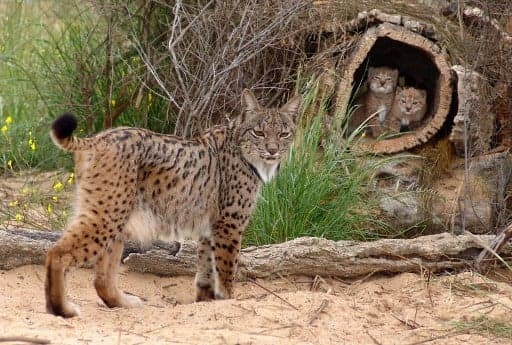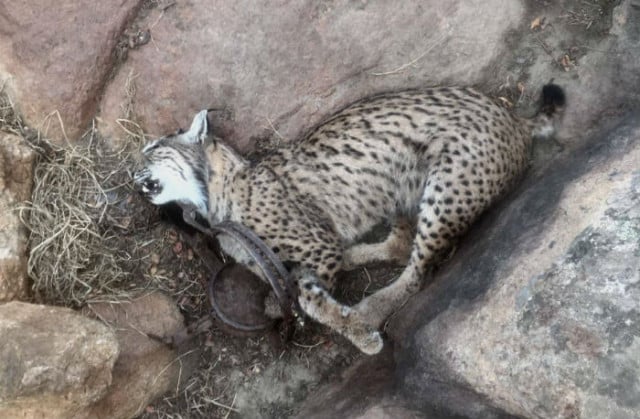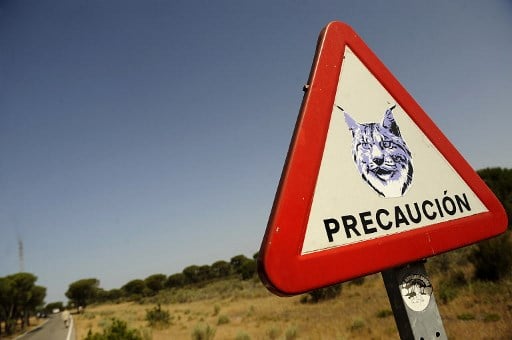WARNING GRAPHIC IMAGES: Four Iberian lynx killed by hunters in central Spain

Their comeback from the brink of extinction has been hailed as one of Europe’s greatest wildlife success stories, but that has been tainted by the news that at least four Iberian lynx have been killed this year through illegal hunting.
Ecologists in Action have lamented the death of at least four lynx in the Montes de Toledo area since the start of this year, animals that were released into the wild as part of a reintroduction scheme.
The environmental protection group reported that so far in 2019 two lynx had been shot and two killed in illegal traps. All four of them had been released into the wild under the breeding programme and were being tracked.

An image of one of lynx killed in an illegal trap. Photo: Ecologistas en Acción
“Especially tragic was the death of Nenúfar, a breeding female with four young cubs , who presumably will have been unable to survive in the wild at such a young age,” explained Miguel Hernández, a spokesman for Ecologists in Action.
Nenúfar gave birth to four pups in April and was shot dead in June.
The other three killed by hunters were young males named Planeta, Peñafiel and Marzipan.
Ecologists in Action have called for greater transparency from authorities in Castilla-La Mancha in investigating the deaths of animals which are already afforded the greatest protection under law.
The group has also called for greater vigilance during the upcoming hunting season.
The penalties for illegally hunting the elusive cats are huge but it is hard to police, and lynx are regularly reported to have been accidentally killed in traps laid by farmers to catch foxes.
The roads pose a huge danger, with another four animals being run over in Monte del Toledo since the start of the year.

A roadside warning drivers to be vigilent within known Lynx territory. Photo: AFP
During the past five years alone, close to 100 animals have been hit by cars and found dead at the side of the roads, a fact which conservationists hope to limit through the building of culverts and ecoducts that cross under or over highways.
A network of such structures are currently planned for the use of lynx.
Lynx pardinus was once found throughout Spain, Portugal and parts of southern France, with a population at the turn of the 20th Century estimated at some 100,000.
But, much prized for their luxuriant coat and as a trophy, years of over-hunting devastated the population, bringing the estimated number living in the wild to below 10,000 by the end of the 1980s.
Lynx numbers were further devastated as construction projects and new highways eroded their territory and made them roadkill.
En 2019 al menos cuatro linces ibéricos han muerto en los Montes de Toledo por disparos de escopeta y trampas. Ecologistas en Acción reclamamos transparencia y una acción contundente de cese de la caza en las zonas donde han aparecido los linces muertos. https://t.co/CQhaTN6MyK
— Ecologistas en Acción (@ecologistas) October 3, 2019
By 2002, the Iberian lynx was identified as the world's most endangered cat, with just 94 left in the wild and looked all set to become the first species of cat to die out since the sabre-toothed tiger 10,000 years ago.
Faced with the likelihood that the lynx would become extinct the Spanish government launched an emergency campaign to save Europe's largest cat and established a captive breeding programme which would culminate in them being reintroduced to the wild.
Thanks to joint funding between the EU and Spanish administrations to the tune of €100 million according to El Pais, four breeding centres have been established within Spain, and another in Portugal and have led to 185 young lynx being released into the wild over the past decade.
At the last census in early 2019, the wild lynx population numbered 686 across a territory of over 3,064 km/sq spread across Andalusia, Castilla-La Mancha and Extremadura and across the border into southern Portugal.
They have even been spotted in Madrid and, most extraordinarily, on the outskirts of Barcelona.
Such has been the success that in 2015, the International Union for the Conservation of Nature (IUCN) downgraded the danger of the Iberian Lynx from “Critically Endangered” to “Endangered” but indicated that if conservation continues in the same way it is likely to be listed as “Vulnerable” by the middle of the next decade.
READ MORE: How Spain brought the Iberian Lynx back from the brink of extinction
Comments
See Also
Ecologists in Action have lamented the death of at least four lynx in the Montes de Toledo area since the start of this year, animals that were released into the wild as part of a reintroduction scheme.
The environmental protection group reported that so far in 2019 two lynx had been shot and two killed in illegal traps. All four of them had been released into the wild under the breeding programme and were being tracked.

An image of one of lynx killed in an illegal trap. Photo: Ecologistas en Acción
“Especially tragic was the death of Nenúfar, a breeding female with four young cubs , who presumably will have been unable to survive in the wild at such a young age,” explained Miguel Hernández, a spokesman for Ecologists in Action.
Nenúfar gave birth to four pups in April and was shot dead in June.
The other three killed by hunters were young males named Planeta, Peñafiel and Marzipan.
Ecologists in Action have called for greater transparency from authorities in Castilla-La Mancha in investigating the deaths of animals which are already afforded the greatest protection under law.
The group has also called for greater vigilance during the upcoming hunting season.
The penalties for illegally hunting the elusive cats are huge but it is hard to police, and lynx are regularly reported to have been accidentally killed in traps laid by farmers to catch foxes.
The roads pose a huge danger, with another four animals being run over in Monte del Toledo since the start of the year.

A roadside warning drivers to be vigilent within known Lynx territory. Photo: AFP
During the past five years alone, close to 100 animals have been hit by cars and found dead at the side of the roads, a fact which conservationists hope to limit through the building of culverts and ecoducts that cross under or over highways.
A network of such structures are currently planned for the use of lynx.
Lynx pardinus was once found throughout Spain, Portugal and parts of southern France, with a population at the turn of the 20th Century estimated at some 100,000.
But, much prized for their luxuriant coat and as a trophy, years of over-hunting devastated the population, bringing the estimated number living in the wild to below 10,000 by the end of the 1980s.
Lynx numbers were further devastated as construction projects and new highways eroded their territory and made them roadkill.
En 2019 al menos cuatro linces ibéricos han muerto en los Montes de Toledo por disparos de escopeta y trampas. Ecologistas en Acción reclamamos transparencia y una acción contundente de cese de la caza en las zonas donde han aparecido los linces muertos. https://t.co/CQhaTN6MyK
— Ecologistas en Acción (@ecologistas) October 3, 2019
By 2002, the Iberian lynx was identified as the world's most endangered cat, with just 94 left in the wild and looked all set to become the first species of cat to die out since the sabre-toothed tiger 10,000 years ago.
Faced with the likelihood that the lynx would become extinct the Spanish government launched an emergency campaign to save Europe's largest cat and established a captive breeding programme which would culminate in them being reintroduced to the wild.
Thanks to joint funding between the EU and Spanish administrations to the tune of €100 million according to El Pais, four breeding centres have been established within Spain, and another in Portugal and have led to 185 young lynx being released into the wild over the past decade.
At the last census in early 2019, the wild lynx population numbered 686 across a territory of over 3,064 km/sq spread across Andalusia, Castilla-La Mancha and Extremadura and across the border into southern Portugal.
They have even been spotted in Madrid and, most extraordinarily, on the outskirts of Barcelona.
Such has been the success that in 2015, the International Union for the Conservation of Nature (IUCN) downgraded the danger of the Iberian Lynx from “Critically Endangered” to “Endangered” but indicated that if conservation continues in the same way it is likely to be listed as “Vulnerable” by the middle of the next decade.
READ MORE: How Spain brought the Iberian Lynx back from the brink of extinction
Join the conversation in our comments section below. Share your own views and experience and if you have a question or suggestion for our journalists then email us at [email protected].
Please keep comments civil, constructive and on topic – and make sure to read our terms of use before getting involved.
Please log in here to leave a comment.